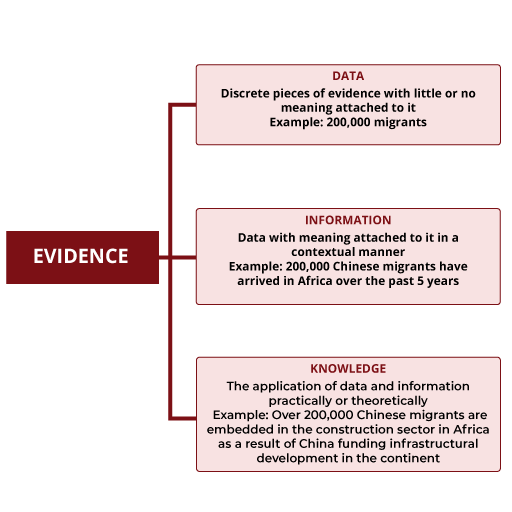4.1 Migration data, information and knowledge
As Unit 2 discussed, evidence can come from many different sources. Here we look at those sources in a little more detail. We also pick up on how migration evidence can map onto the Evidence Pyramid of data, information or knowledge:
Data : raw migration data without meaning, e.g. migration numbers, quotes from migrants.Information: migrant data with attached meaning for ‘who, what, where, when’ as regards migration issues.Knowledge : insight on ‘why and how’ migrant information can be used and applied to change issues, e.g. theories and models of migration.
An example of migration data
Table 4.1: Chinese workers in Kenya and Africa, 2013–2018
| Africa (data) | Kenya (data) | |
|---|---|---|
| 2013 | 214,534 | 2690 |
| 2014 | 259,370 | 4938 |
| 2015 | 263,659 | 7436 |
| 2016 | 263,659 | 8159 |
| 2017 | 263,659 | 8703 |
| 2018 | 263,659 | 9131 |
Migration information is migrant data that has been summarised, aggregated or processed, and is therefore easy to share. Migration data is considered ‘information’ when context is provided: which group(s) the data represents, how was the data collected, why, and when and where it was collected. Turning information into knowledge is complex, and it requires a deeper understanding of the context, rather than simple meaning.
Turning data into information
Let’s look at an example using the data from Table 4.1: Chinese workers in Kenya and Africa:
In the table you might notice a surge in 2014. We can add simple meaning to these figures with the added information that Kenya formed a new government, whose agenda was infrastructural development and who created the Public Private Partnership Act in 2013. Chinese companies were contracted to lead various infrastructure development projects.
In 2016 you might have noticed a decrease in the total number of Chinese workers in Africa. This is attributed partly to the civil unrest in Sudan. Prior to that, Sudan was one of the major destinations of Chinese workers in Africa, largely due China’s funding of major infrastructural projects in Kenya and the consequent trade agreements by both governments.
Migration knowledge is often practically and theoretically developed from data and information. It focuses on:
- Origin: where do migrants come from?
- Destination: which countries would you find migrants of a particular origin?
- Distribution: where are the largest flows?
- Demography: what is the age and sex, education and income of migrants?
- Impact: demographic, economic and social impacts on sending and receiving countries
The evidence typology gives a visual representation of this continuum and the increasing amount of evidence at these different levels. In the evidence typology shown in Figure 4.1, the data represents a sample point that shows there are 200,000 migrants. We can find various types of data such as arrivals by country of origin, stock of migrants, stock of migrants by sex etc. Data is often presented in tabular forms with headings or as answers on questionnaires.
This data still needs to be interpreted in the context of the questions we ask. Are we interested in arrivals in Africa by country of origin? Or more specifically in Chinese migrants? Information helps us to contextualise this data in relation to our subject of study.
A more detailed form of evidence is knowledge. We may combine or process data and information to generate knowledge. If we find that there is an association between funding infrastructural development and Chinese migrants, and this specific to the construction sector, then we can call this knowledge. We may find such information by asking key informants such as government officials about infrastructural development funding and how this relates to Chinese migration in Africa.
 Activity 4.1 Migration data, information and knowledge
Activity 4.1 Migration data, information and knowledge
When you pass through an airport you often fill in a yellow ‘landing card’. In terms of migration evidence do you think this is data or information? Where do you think this evidence goes?
The Nigeria Immigration Service periodically releases data on arrivals and departures, but as researchers we need more information, such as whether foreigners who have come into Nigeria are there for tourism, to visit family, to work, or for other reasons. Spend a few minutes thinking of some examples that differentiate between data and information in your own work.
Discussion
Given that we work in diverse migration contexts, there will be many possible responses to this prompt. In my own context as a migration researcher in Nigeria, evidence presented on Africa, shows that about 60% of migrants remain within the region. This strikes me as conflicting with what I know about migrants from Nigeria, since only 30% of them remain within the region as inferred from the World Bank bilateral migration estimates. It matters for me to note that the African figures were average values and did not reflect the reality for outliers such as migrants from Morocco, Nigeria, or South Africa in 2018, whose migrants tended to go outside the continent.
Just as evidence comes in many forms, it also comes from many sources. No single source by itself can give a complete picture so you may need to combine sources. Next, you will discover some of the main sources
Introduction

